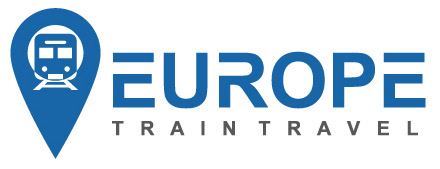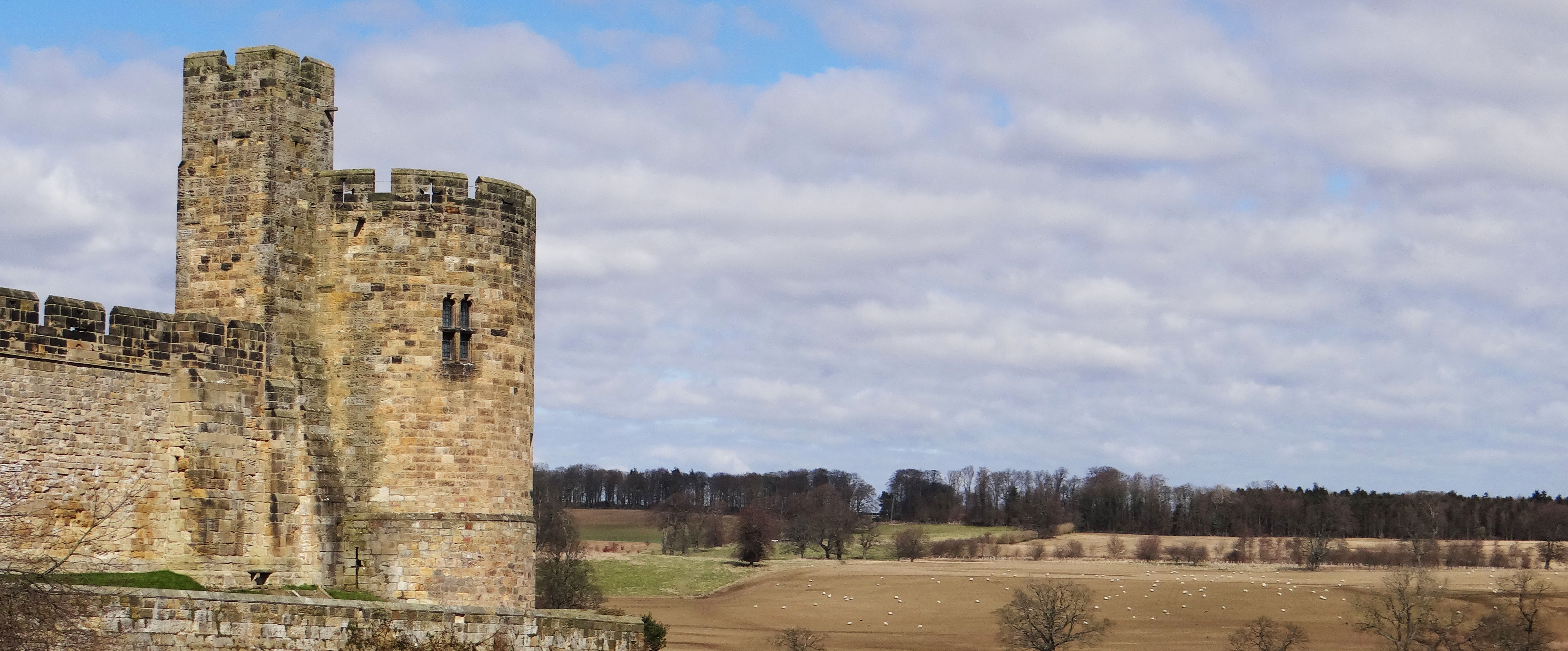
Brainstorming Destinations: The Challenge
Europe is large, dense, beautiful and exciting place to explore. No country is similar and each city and town has its unique character. It is a big patchwork of cultures, traditions, lifestyle, art, archi- tecture and nature. That is what makes deciding destinations hard. The options are endless and the destinations numerous. You might decide to visit one or more cities, explore a certain country or jump around the most popular European destinations. It is not what you would call one of the ‘hard decisions in life’ but it is definitely not easy, especially if you are overwhelmed with all the places being suggested in tourist guides. To start your planning, take a breath and answer the following questions:
How many days am I planning to travel?
How many destinations would I like to visit in this time?
What type of destinations am I looking for?
- The sightseeing you would like to see (Eiffel tower, Colosseum, Big Ben etc.)
- Cities you would like to walk (the canals of Venice, the romantic streets of Prague, the bridges of Budapest etc.)
- Food you would like to taste (tapas in Spain, pizzas in Italy, fresh fish dishes in Greece, etc.)
- People you would like to visit (your friend in Berlin, a cousin in a small French town etc.), or
- Events and activities that you would like to experience (Oktoberfest Beer Festival in Germany, skiing in the Alps, hiking in Switzerland, fishing in Scandinavian lakes etc.) Our best suggestion is to try to combine these options. People tend to get ‘blinded’ to the things they repeatedly see.
Try to mix it and keep it colorful. For example, if you visit more big cities in a row you will realize that less things attract your attention each day. If you visit more museums in a row, you will also feel your interest wearing off with time. The best way to keep things ‘fresh’ would be to mix the destinations and activities: after sightseeing in a big city, go for some hiking, bike along a river of a smaller traditional town or spend a day to a festival/event before you go on with another city.
How am I going to decide on destinations?
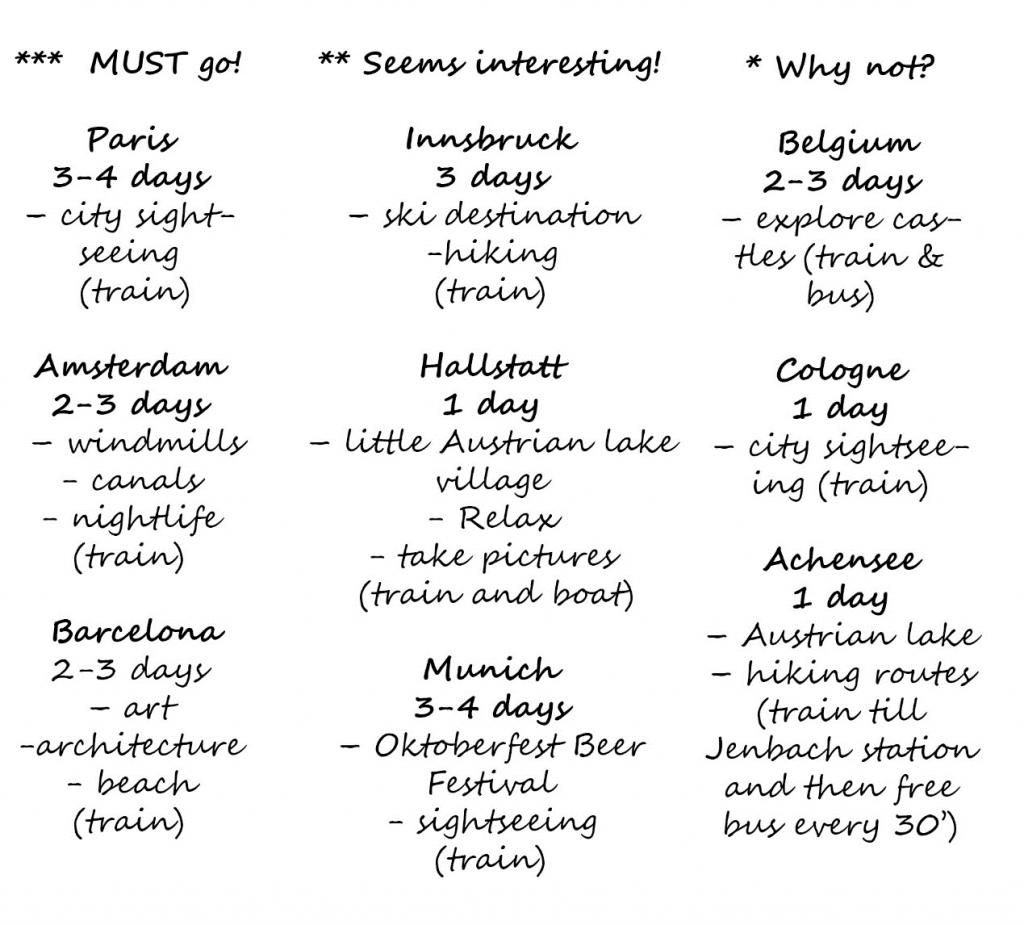 That is the first step of your planning. Your route now will develop depending on the location of each place, the accessibility, the train connections, the travel time and your preference.
That is the first step of your planning. Your route now will develop depending on the location of each place, the accessibility, the train connections, the travel time and your preference. Locating destinations and drawing a route
Grab your destinations list: it is time to see where exactly everything is. Pinning destinations on a map (paper on digital one) could be the best way to make it visual. Pin for example the places that you ‘must-go’ with red, the ‘places that would like to visit’ with green and the places that could be ‘interesting alternatives’ with yellow. 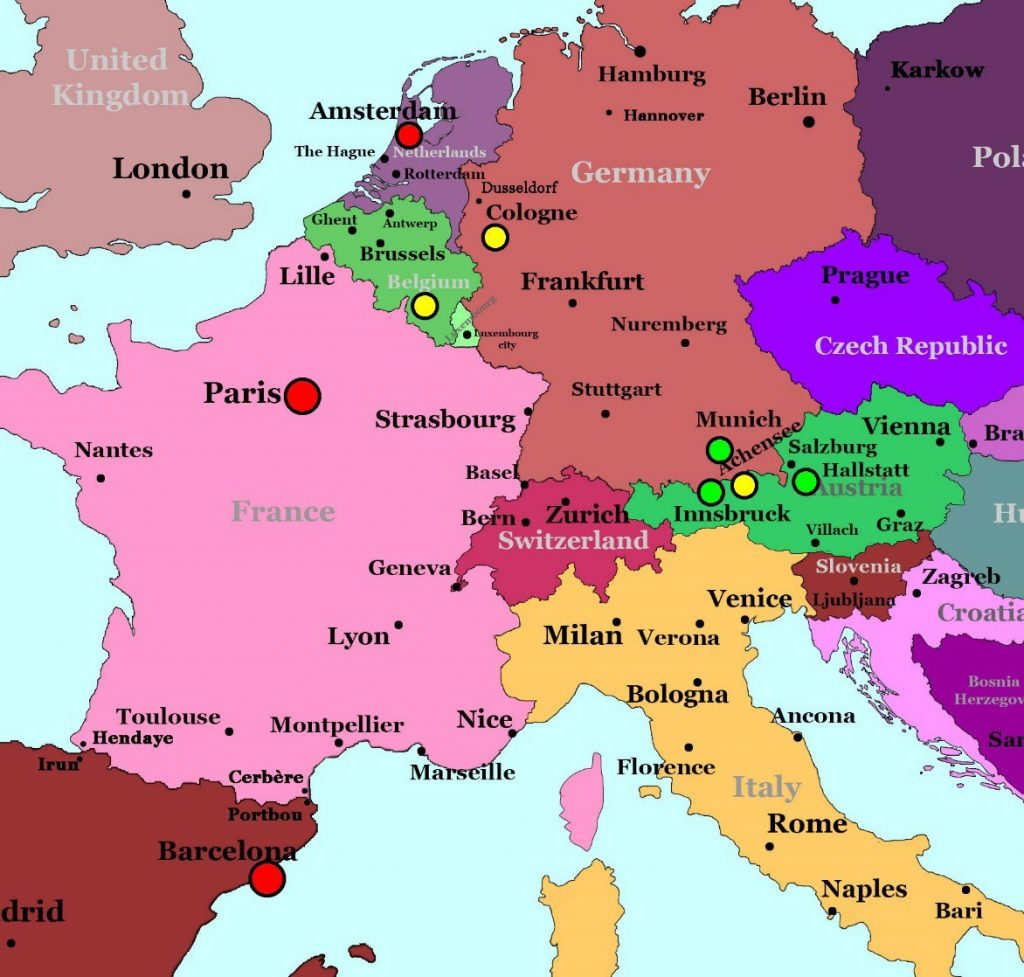 Locate the red pins with the places that you ‘must-go’ and have a look at the route that they form. That could be your main route. Calculate the days that you will need for your ‘must go’ destinations. Then, have a look at your green pins with the ‘places that you would like to visit’. Which of them are on your way? Which ones are further away? For how many of them would you have time? Last, check your yellow dots. Which are close to one of the decided destinations? Could they become a day trip? Could they be an overnight ‘stop-over’ to break a long train trip? Do you still have time for them? At the end, you can see a draft picture of your possible route and the alternatives. You might have more destinations and a more complicated travel plan. You might also decide to cancel destinations that are further away or destinations that are not that easily accessible. Example: On the map above, the places of your destination list are located. Exploring your map, you might decide that Barcelona is too far from the other destinations and you prefer to explore Munich and the cities in Austria that are closer to each other. You might also see that Achensee lake is very close to Innsbruck so it could become a day trip. However, locating the destinations is only the one part of the story. The other part are the connections between those destinations. How do the train connections look like? How long does the route take? Does the train have to go through a mountain range or around a lake? Europe has mountains, cliffs, lakes and rivers that define the train routes. Before you assume that places are close because they look close, have a look at the landscape of the area. Especially in Austria, Spain and Scandinavia what looks close can be a longer train trip than expected because of rough mountains. Do a fast research by simply using a search engine from a rail website to find the average time that it takes for each route. In the example above, Hallstatt looks close to Innsbruck, so you might think that this could be a day trip destination. However, you have to go around the mountains and change 2-3 trains to get there, which makes it a solid 4-5 hour train trip just to reach there. Depending on your preferences, you can either rule Hallstatt out as a destination, or add Salzburg –the closest bigger city to Hallstatt- as a destination. From Salzburg, the train trip to Hallstatt is 2,3h.
Locate the red pins with the places that you ‘must-go’ and have a look at the route that they form. That could be your main route. Calculate the days that you will need for your ‘must go’ destinations. Then, have a look at your green pins with the ‘places that you would like to visit’. Which of them are on your way? Which ones are further away? For how many of them would you have time? Last, check your yellow dots. Which are close to one of the decided destinations? Could they become a day trip? Could they be an overnight ‘stop-over’ to break a long train trip? Do you still have time for them? At the end, you can see a draft picture of your possible route and the alternatives. You might have more destinations and a more complicated travel plan. You might also decide to cancel destinations that are further away or destinations that are not that easily accessible. Example: On the map above, the places of your destination list are located. Exploring your map, you might decide that Barcelona is too far from the other destinations and you prefer to explore Munich and the cities in Austria that are closer to each other. You might also see that Achensee lake is very close to Innsbruck so it could become a day trip. However, locating the destinations is only the one part of the story. The other part are the connections between those destinations. How do the train connections look like? How long does the route take? Does the train have to go through a mountain range or around a lake? Europe has mountains, cliffs, lakes and rivers that define the train routes. Before you assume that places are close because they look close, have a look at the landscape of the area. Especially in Austria, Spain and Scandinavia what looks close can be a longer train trip than expected because of rough mountains. Do a fast research by simply using a search engine from a rail website to find the average time that it takes for each route. In the example above, Hallstatt looks close to Innsbruck, so you might think that this could be a day trip destination. However, you have to go around the mountains and change 2-3 trains to get there, which makes it a solid 4-5 hour train trip just to reach there. Depending on your preferences, you can either rule Hallstatt out as a destination, or add Salzburg –the closest bigger city to Hallstatt- as a destination. From Salzburg, the train trip to Hallstatt is 2,3h.
Basic Country Information
Before going on with your planning, take a step back and get familiar with the countries that you intend to visit. Make sure that you have the right travel documents in order to enter the country, check whether the country belongs to European Union or Schengen area, get information about its currency, the time zone and – in case that you want to use a rail pass- make sure that the pass is valid in this country.
- Travel documents
The documents that you need in order to enter each country depend on your nationality and the country itself. European nationals are able to travel within Europe and the Schengen area with their national ID or passport. Non-European nationals usually need a valid passport and possibly a visa. Check the type of travel document that you will need in the early stages of your planning and allow some time in case that there are documents that need to be issued.
- Currency
The fact that a country is an EU member does not mean that their currency is euros. Many countries have still their own currency. If you travel in a country with a different currency, your best option is to use your credit card to pay or withdraw money directly from an ATM or a bank. Exchanging cash in exchanging shops are usually more expensive. If you intend to use your credit card, let you bank know about your travel plans. It is quite common for banks to block credit cards when unusual activity is detected (e.g. using the card in different countries). In addition, have the emergency number of your bank with you in case that you have issues or lose your card.
- Interrail/Eurail participating countries
Interrain/Eurrail passes are a convenient way to travel freely in Europe. Most European countries participate in the Interrail/Eurail program – but not all of them! Be aware of this and before purchasing such a pass check whether the countries you want to visit participate in Interrail/Eurail offer.
- Time zone
Universal Time Coordinated (UTC) – also known as Greenwich Mean Time (GMT) – is the basis for local times worldwide. Time zones define the time around the world. Europe spreads over four time zones. Time zones usually follow the borders of a country. While travelling it is possible that you will enter a different time zone. Do not forget to note the time zone of each country.
- Daylight Saving Time (DST)
In Europe, most countries change their clocks into Summer Time for some months, in order to make better use of the long sunlight hours of the summer. By “springing” clocks forward an hour in spring, an hour of daylight is being moved from the morning to the evening. In the autumn, the clocks “fall back” and return to Standard Time. If you are travelling around the dates where the time changes (end of March and end of October) be careful not to mess up with your train connections or other scheduled activities.
Searching train connections
Basic search for train connections:
Each country in Europe has an official national rail website where you can find information about train connections, local offers, tickets etc. Usually on the home page, there is a search engine box. Each website is different, but the concept is the same: this search engine is there to help you find the train connection you are looking for.

Search engine of the German rail website, Deutsche Bahn. Source: www.bahn.de

Search engine of the Italian rail website, Trenitalia. Source: www.trenitalia.com
Using the search engine in simple: Fill in your departure and arrival destinations, the date and the time you would like to travel and click on the ‘search’ option. If you want more options, you can click on the ‘advance search’ / ‘further options’ or a similar button. There you can modify details, add travelers, discount cards, return tickets, book only seat reservations, decide waiting time between trains connections or include only certain transport types to your research (regional trains, high speed trains, buses etc.).
Advanced search for train connections:
If you did the basic research for a train connection but you are not happy with the results and you think there should be more to it, well, there is more to it. If you understand how search engines work and add your ‘human mind’ to it, you can create yourself more options. Search engines are set to detect the quickest connections with the shortest waiting time between them. If there is a train leaving a couple of minutes later, takes a couple of minutes longer or has a slightly longer waiting time at the train station, it will possibly not be shown in the results, espe- cially if the route consists of more than two connections. However, this connection might still have discounted tickets (since it does not appear in the results it is less popular) or a more convenient schedule. Here are some tricks, starting from the simplest one:
Trick 1: Change the ‘Transfer duration’ of your connection

Transfer time. Source :www.bahn.de
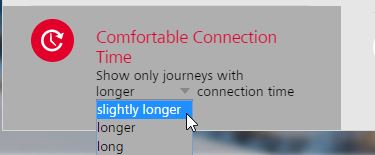
transfer time Source: www.oebb.at
By changing the time between connections, you force the search engine to reveal the next possible option. Play a bit around searching for connections with a minimum of 10, 15, 20, 25, 30 minutes between train connections. This way you can detect offer tickets that are not being shown because the connection is not the first one detected (and because no one thought to search selecting ‘at least 20 minutes between train connections’). You may also find more convenient connections (e.g. you prefer a bigger break in a long route to get some lunch) or your preferred type of train (e.g. trains that do not need reservations). Tip: Do not book connections that give you less than 5-10 minutes transfer time. Remember that you need a couple of minutes to get out of the train, detect where your next train leaves from and walk to the platform. It is very common for trains to have a couple of minutes delay, especially when they are approaching busy train stations. It is highly recommended to leave 10-20 minutes transfer time between local connections and 30 – 40 between international connections – especially in peak seasons.
Trick 2: Check train connections in each country separately

Price for the route Bologna – Munich. Source: www.trenitalia.com

Price for the route Bologna – Munich. Source: www.bahn.de
As you can see, the price difference can be significant.
Trick 3: Book train routes till the borders
Trick 4: Break your route down
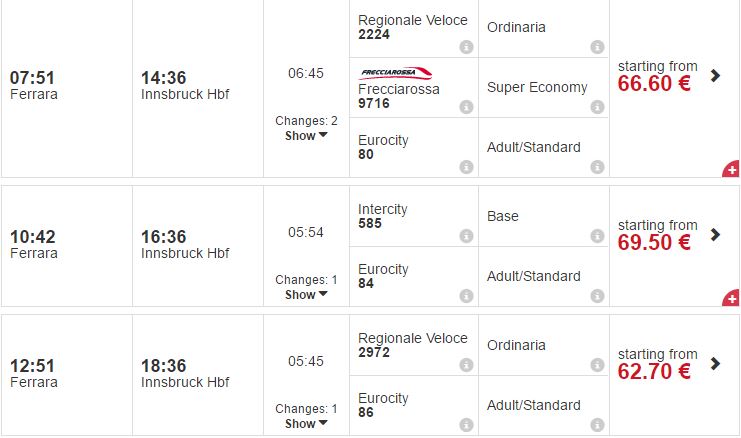 (Source: www.trenitalia.com) To see the main train stops of this route, open the details of each route (click ‘Show’ under the ‘Changes’).
(Source: www.trenitalia.com) To see the main train stops of this route, open the details of each route (click ‘Show’ under the ‘Changes’). 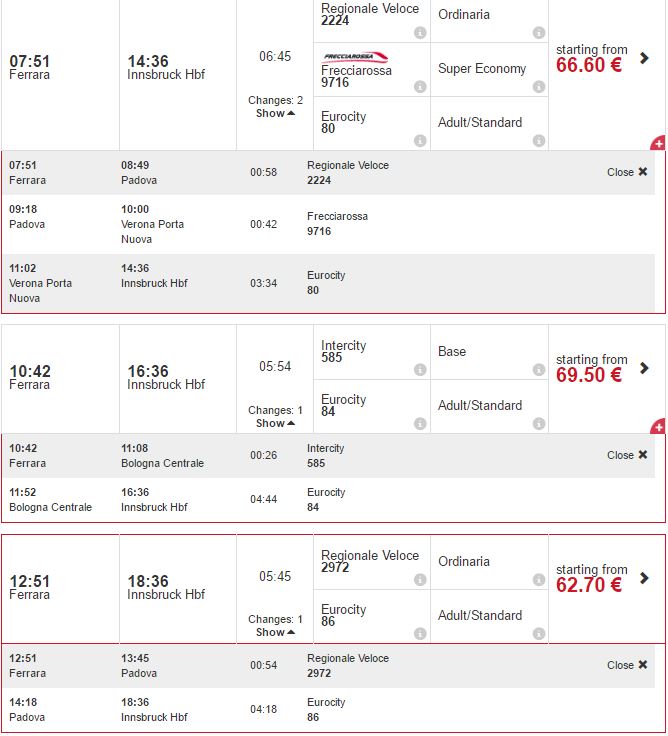 (Source: www.trenitalia.com) You can easily see that the main train stations of this route are Padova, Verona (Verona in case you go through Padova) and Bologna. Step 2: Split the main route into shorter routes Have a look at the connection details of each route. This is your route already broken down in short- er ‘one-train’ routes. In case you have more stops, you can try alternative connections from each stop to the final destination (e.g. a route that looks like A-B-C-D can break down to not only A-B, B-C, C-D but also A-C and B-D). Example: In the example Ferrara-Innsbruck, the main route can be broken down into the shorter routes: Ferrara – Padova Padova – Verona Verona – Innsbruck (but also Ferrara-Verona, Padova-Innsbruck) or Ferrara – Bologna Bologna– Innsbruck or Ferrara – Padova Padova – Innsbruck Step three: Search connections of your shorter routes Your next step is to fill in the search engine with these shorter routes. This way you can see the trains that were not been picked from the search machine at your basic search. You can see all trains linking this part of your route. Doing that gives you better flexibility. If the initial results suggest you to take a high-speed train which you would prefer to avoid, you can look for the next regional train. If you would like to have a break and spend a couple of hours at one of the stops, just note the train that is convenient for you to continue your route. Example: The first route option goes through Verona (the popular city of ‘Romeo and Juliet’). Seeing that you have an hour transfer time there, you might decide to take some more time and explore the city. Therefore, instead of departing at 11 as your plan suggests, you can search for later options for the route part Verona-Innsbruck. In case you decide to take one of the trains that depart later, remember to book two separate tickets: Ferrara-Verona and Verona-Innsbruck (since there is a bigger break than suggested, they are being considered two separate routes).
(Source: www.trenitalia.com) You can easily see that the main train stations of this route are Padova, Verona (Verona in case you go through Padova) and Bologna. Step 2: Split the main route into shorter routes Have a look at the connection details of each route. This is your route already broken down in short- er ‘one-train’ routes. In case you have more stops, you can try alternative connections from each stop to the final destination (e.g. a route that looks like A-B-C-D can break down to not only A-B, B-C, C-D but also A-C and B-D). Example: In the example Ferrara-Innsbruck, the main route can be broken down into the shorter routes: Ferrara – Padova Padova – Verona Verona – Innsbruck (but also Ferrara-Verona, Padova-Innsbruck) or Ferrara – Bologna Bologna– Innsbruck or Ferrara – Padova Padova – Innsbruck Step three: Search connections of your shorter routes Your next step is to fill in the search engine with these shorter routes. This way you can see the trains that were not been picked from the search machine at your basic search. You can see all trains linking this part of your route. Doing that gives you better flexibility. If the initial results suggest you to take a high-speed train which you would prefer to avoid, you can look for the next regional train. If you would like to have a break and spend a couple of hours at one of the stops, just note the train that is convenient for you to continue your route. Example: The first route option goes through Verona (the popular city of ‘Romeo and Juliet’). Seeing that you have an hour transfer time there, you might decide to take some more time and explore the city. Therefore, instead of departing at 11 as your plan suggests, you can search for later options for the route part Verona-Innsbruck. In case you decide to take one of the trains that depart later, remember to book two separate tickets: Ferrara-Verona and Verona-Innsbruck (since there is a bigger break than suggested, they are being considered two separate routes). 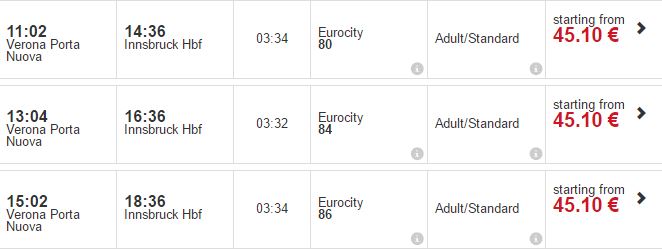 (Source: www.trenitalia.com) The second route option suggests an Intercity train from Ferrara to Bologna. This is a more ex- pensive high-speed train that just covers a short part of the route. If you are on a budget, have a look at the previous trains that foe the same route Ferrara – Bologna.
(Source: www.trenitalia.com) The second route option suggests an Intercity train from Ferrara to Bologna. This is a more ex- pensive high-speed train that just covers a short part of the route. If you are on a budget, have a look at the previous trains that foe the same route Ferrara – Bologna.  (Source: www.trenitalia.com) Breaking down routes can be time consuming and confusing. There is no need to break down routes if you are happy with the connections suggested. However, it is a great way to tailor routes to your preference and explore all of your options.
(Source: www.trenitalia.com) Breaking down routes can be time consuming and confusing. There is no need to break down routes if you are happy with the connections suggested. However, it is a great way to tailor routes to your preference and explore all of your options. How to find further details about your train
What is the exact route of a train? Where does it stop? Does a train have a restaurant or other food options? Do I need a reservation? Is there a family compartment? Is it wheelchair friendly? Does it allow the transport of bicycles? Such information is good to know when planning and while travel- ing. Where can you find all this information? First, you have to select the route that you are interested in. By clicking on a “details”, “further information” or similar button located around your selected route you can see details of your route and the trains that it includes. The information that rail websites provide differ from country to country. Here are three examples of detecting further train information, using websites with different levels of information revealed:
Example 1: Comprehensive information
The German rail website (www.bahn.de)
Fill in your departure, destination, travel date and time and select “Search”: 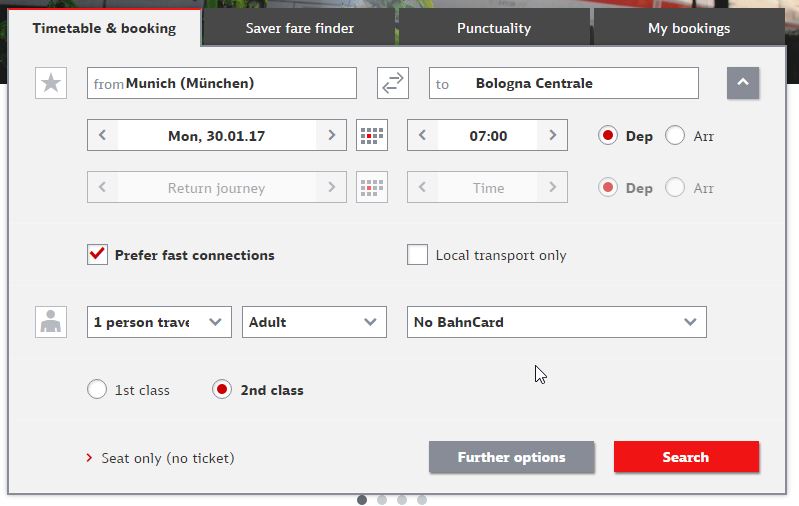 Have a look at the options that the search will reveal:
Have a look at the options that the search will reveal: 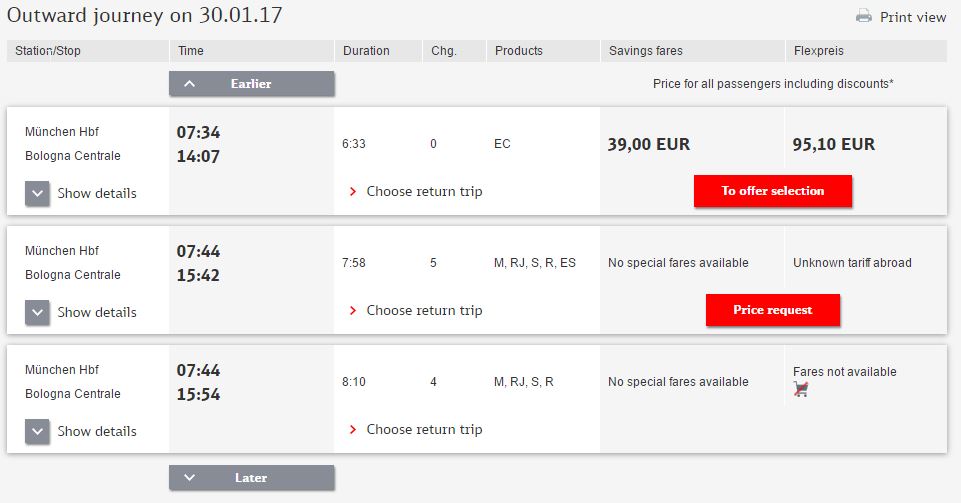 (Source: www.bahn.de) Under the ‘Chg’ (‘Changes’) column, you can see how many times you will need to change trains to get to your destination. Let us assume that you are interested in the first option where you can get a direct train (0 changes). To find further information about this train, click on the “Show details” option just under your selected route. Having a closer look, you can see that there is a “Further information” column.
(Source: www.bahn.de) Under the ‘Chg’ (‘Changes’) column, you can see how many times you will need to change trains to get to your destination. Let us assume that you are interested in the first option where you can get a direct train (0 changes). To find further information about this train, click on the “Show details” option just under your selected route. Having a closer look, you can see that there is a “Further information” column. 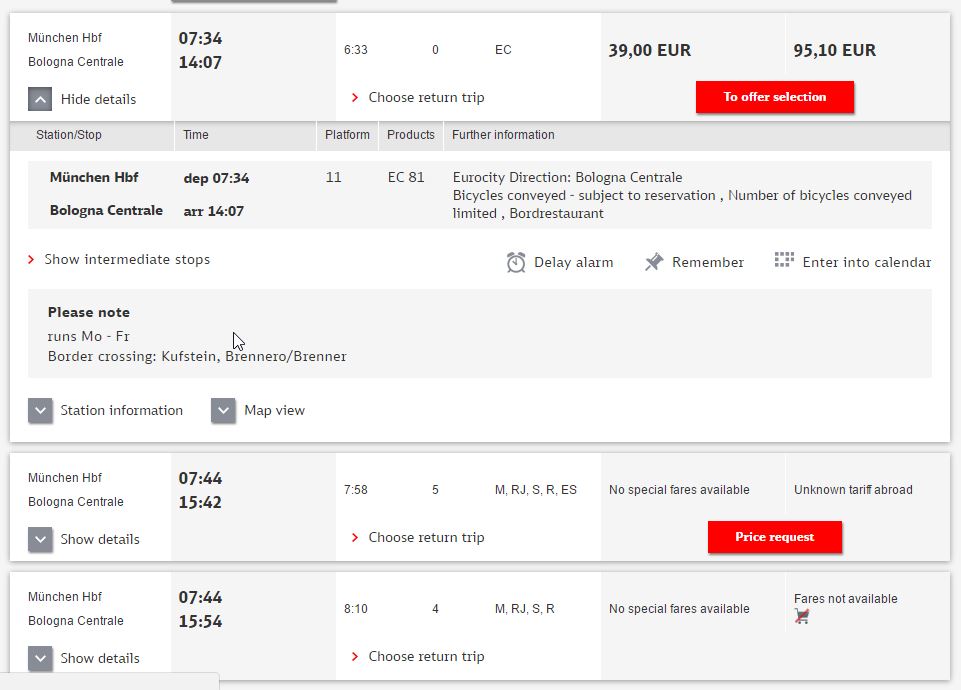 There, you can see the final destination of the train (Bologna), the fact that there is a restaurant on board and the policy about bicycles and reservations:
There, you can see the final destination of the train (Bologna), the fact that there is a restaurant on board and the policy about bicycles and reservations: 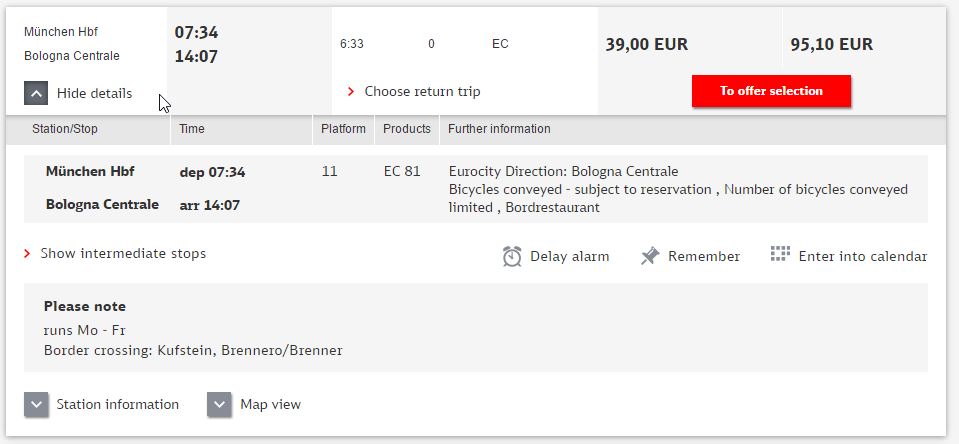 (Source: www.bahn.de) By clicking on “Show intermediate stops” arrow, you can see all the stops, the exact departure time at each station and the platform that it arrives on (platform information is usually not available for destinations out of the country).
(Source: www.bahn.de) By clicking on “Show intermediate stops” arrow, you can see all the stops, the exact departure time at each station and the platform that it arrives on (platform information is usually not available for destinations out of the country). 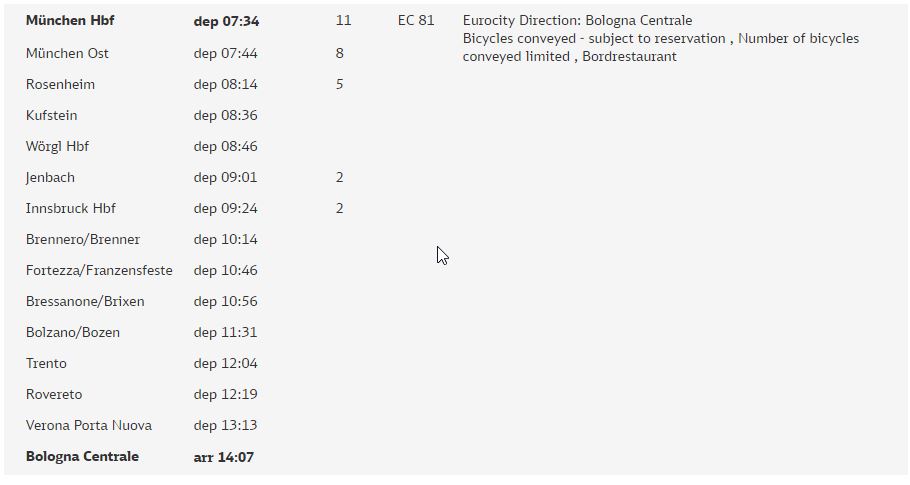 (Source: www.bahn.de) Alternatively, click on the name of the train (EC 81) and a separate page with the route information will open:
(Source: www.bahn.de) Alternatively, click on the name of the train (EC 81) and a separate page with the route information will open: 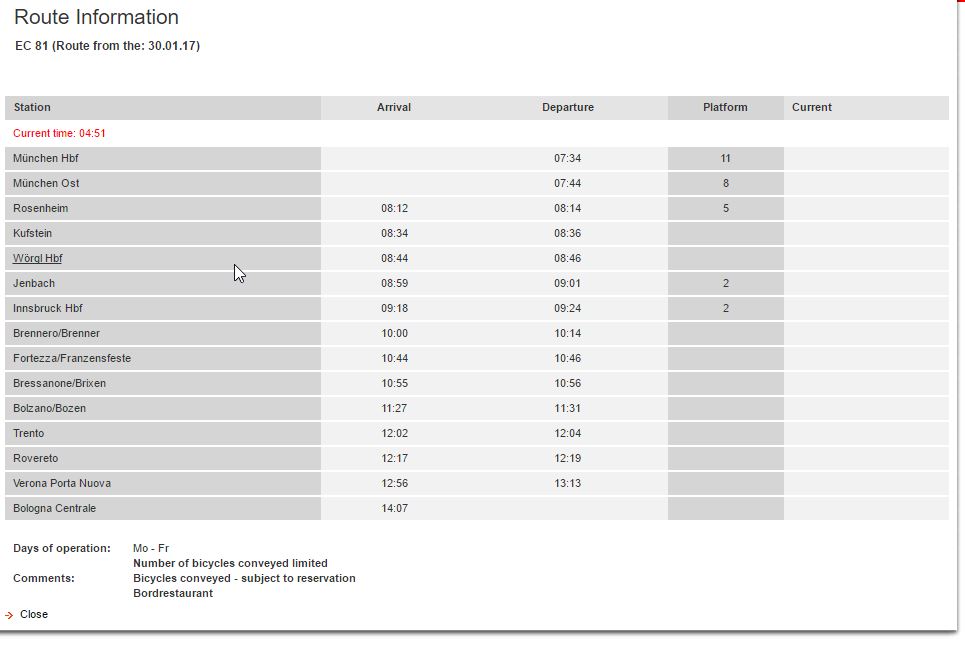 (Source: www.bahn.de) At your initial route details, under the “Station information” you can find the services available at the train station and other useful information like local transport maps:
(Source: www.bahn.de) At your initial route details, under the “Station information” you can find the services available at the train station and other useful information like local transport maps: 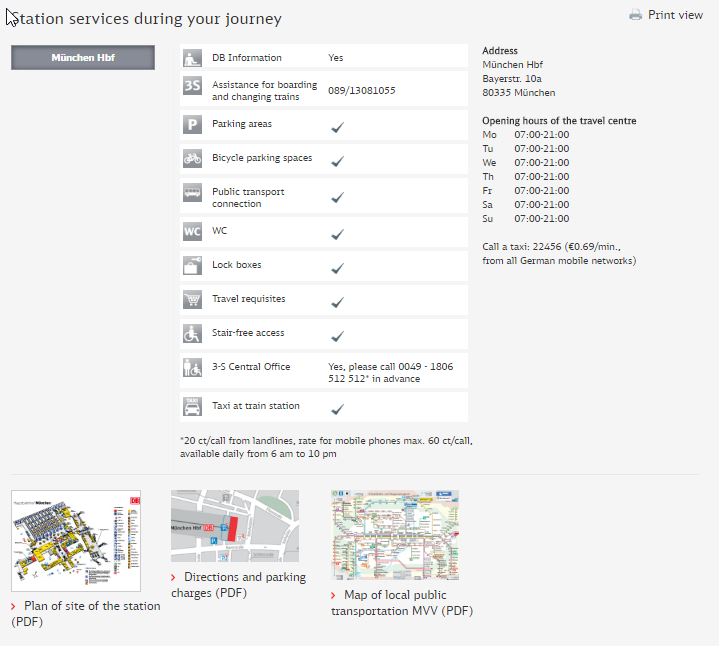 (Source: www.bahn.de) Under “Map view”, you can locate the train route on the map:
(Source: www.bahn.de) Under “Map view”, you can locate the train route on the map: 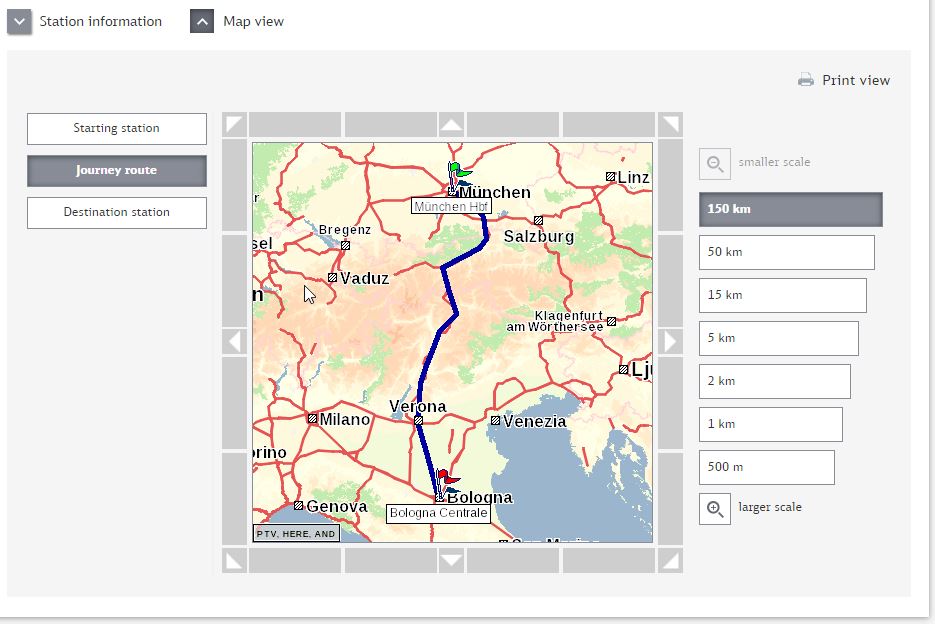 The German rail website (www.bahn.de) is very comprehensive and can give information even for trains that do not run through Germany (for example Barcelona-Madrid):
The German rail website (www.bahn.de) is very comprehensive and can give information even for trains that do not run through Germany (for example Barcelona-Madrid): 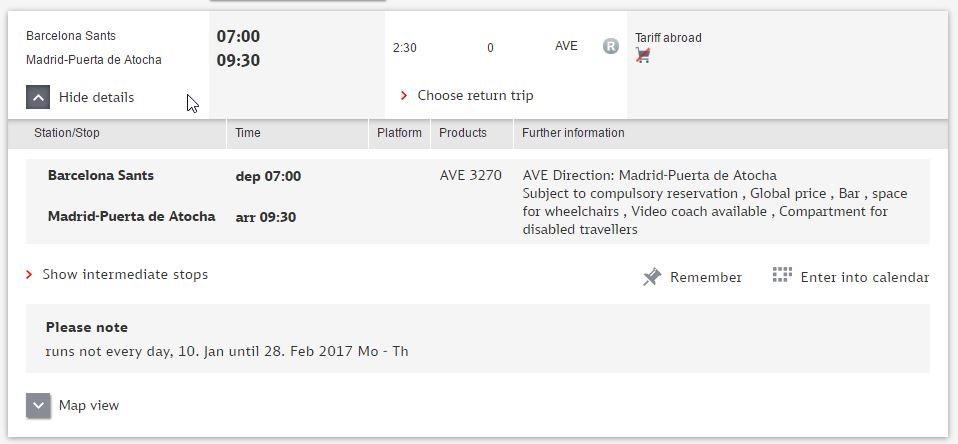 (Source: www.bahn.de)
(Source: www.bahn.de)
Example 2: Basic information
The Italian rail website (www.trenitalia.com)
Fill in your departure, destination, travel date and time and select “Search”:  (Source: www.trenitalia.com) Have a look at the results. Let us assume that you choose the first one where no changes are men- tioned. To find further information for this train you have to click on the “i” symbol at the right down corner of the box where the name of the train is being mentioned (Eurocity 84):
(Source: www.trenitalia.com) Have a look at the results. Let us assume that you choose the first one where no changes are men- tioned. To find further information for this train you have to click on the “i” symbol at the right down corner of the box where the name of the train is being mentioned (Eurocity 84): 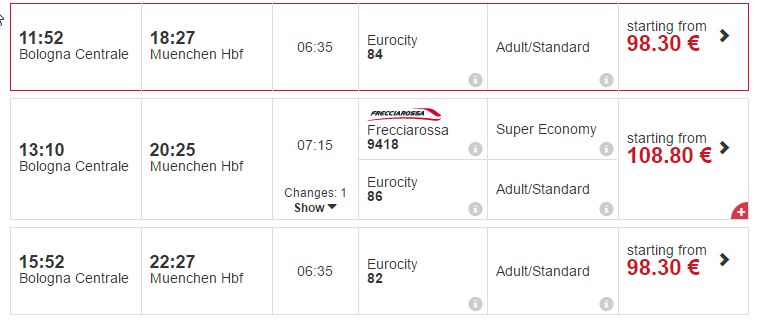 (Source: www.trenitalia.com) Information about this train will show up in a pop-up window (sometimes only in local language).
(Source: www.trenitalia.com) Information about this train will show up in a pop-up window (sometimes only in local language). 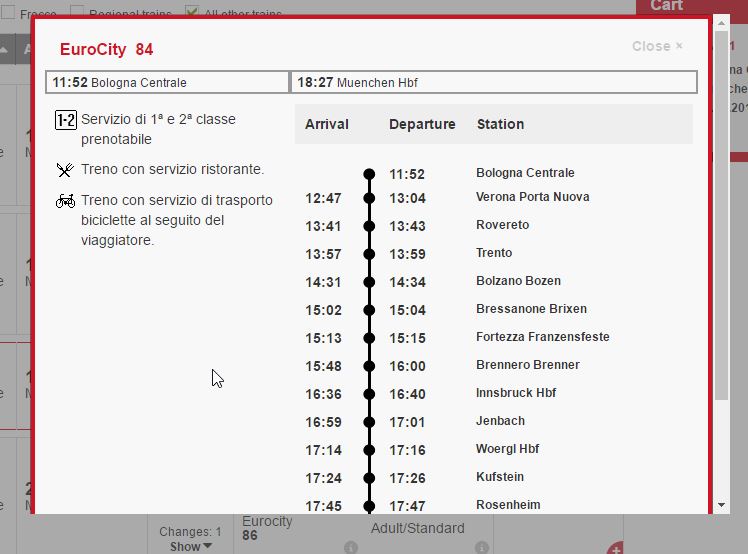 (Source: www.trenitalia.com) There is no further information available about this route.
(Source: www.trenitalia.com) There is no further information available about this route.
Example 3: Poor information and a way around it
The French rail website (www.sncf.com)
Fill in your departure, destination, travel date and time and select “Search”: 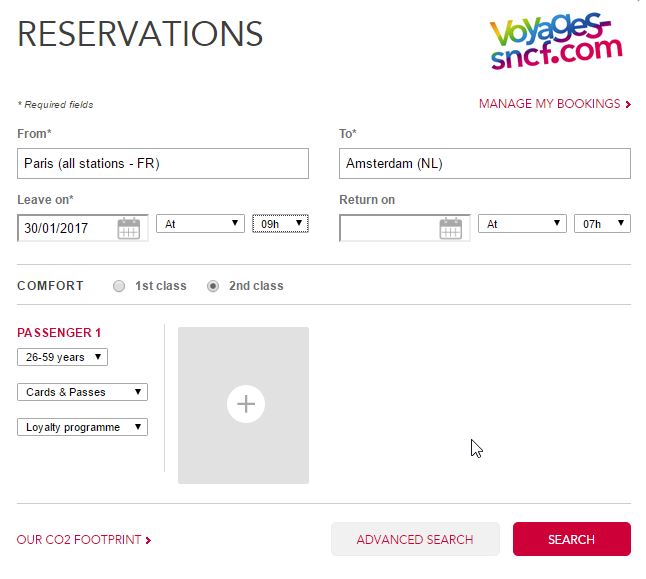 (Source: www.sncf.com) Select one from the options and click on the small arrow that points down to get more information about this train:
(Source: www.sncf.com) Select one from the options and click on the small arrow that points down to get more information about this train: 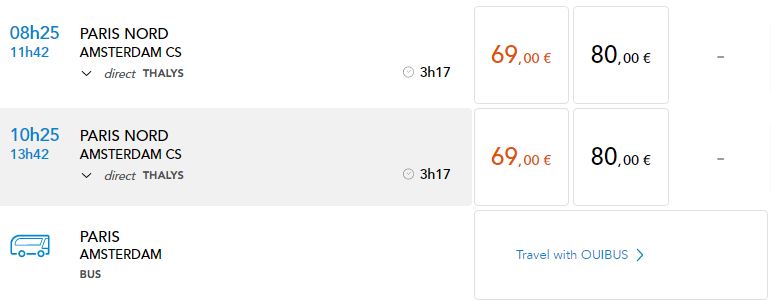 (Source: www.sncf.com) In this case, you can only see very basic information about the train (the train is accessible for dis- abled travelers and there is a buffet car). No further information is available about this route.
(Source: www.sncf.com) In this case, you can only see very basic information about the train (the train is accessible for dis- abled travelers and there is a buffet car). No further information is available about this route. 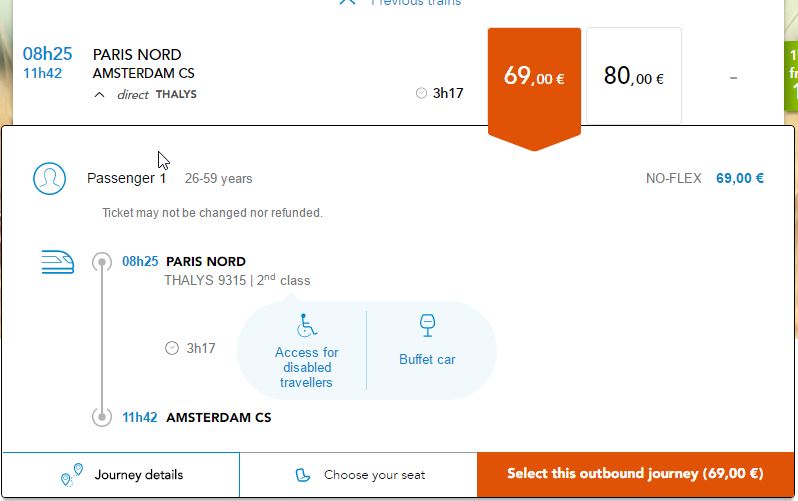 (Source: www.sncf.com) However, as mentioned before, the German website (www.bahn.de) has this piece of information, even if the route does not go through Germany or uses German trains:
(Source: www.sncf.com) However, as mentioned before, the German website (www.bahn.de) has this piece of information, even if the route does not go through Germany or uses German trains: 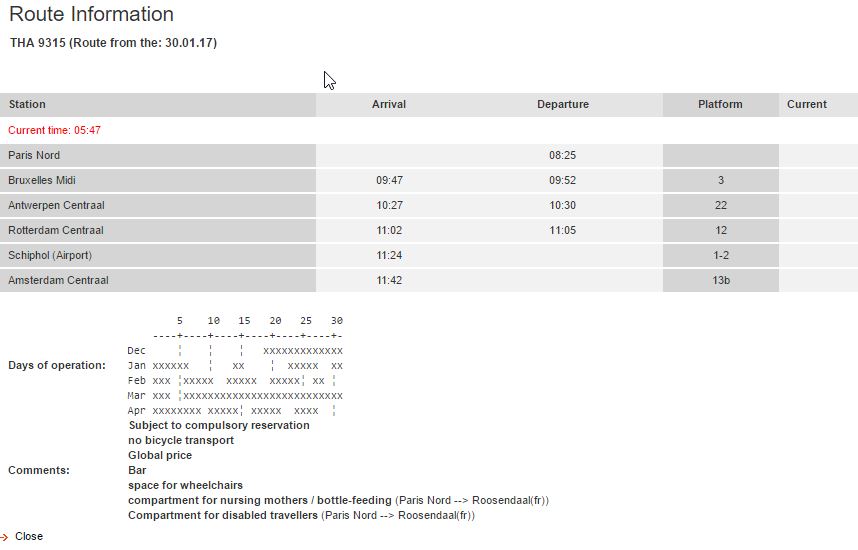 (Source: www.bahn.de)
(Source: www.bahn.de)
- Snack bar: The stuff will go up and down the train offering basic drinks and snacks.
- Bistro: There will be a compartment in the train with few restaurant tables and standing tables. You have the option to sit there or take away what you want and go back to your seat (but there might be different menus for the take away options). They will have a bigger variety of snacks and drinks. Usually you can also get some warm food options (toasts, baguettes, basic meals).
- Restaurant: There will be a compartment in the train with restaurant tables and stuff serving them. There you can find a variety of drinks, snacks and warm dishes. They will also have ‘take away’ options.
The Big Travel Plan
Every traveler should have a travel notebook with the whole plan of the trip: the train routes and the connection alternatives, the hotels that have been booked, the planned activities of each desti- nation and any other information that will be handy to have. The travel plan will be your guide. It is not a program. Just an outline of your options and alternatives, the information that you might need while ‘on the go’, the big picture of your plan. It is the difference between tourists and experi- enced travelers. It does not need more time but it will give you the ability to travel ‘like a pro’.
Train routes with alternatives
- The train’s direction: The final destination of the train. The electronic timetables at train sta- tions are mainly using a train’s final destination. Intermediate stations are not always been men- tioned. For example, if you are going from Frankfurt to Stuttgart but the train continues and ter- minates at Munich, the train destination at the timetable will show Munich. Stuttgart may not be mentioned (or mentioned with small letters below). Make sure you know the final destination of the train you plan to take.
- The train code: The train’s code usually consist of the train company and number and defines each train (for example: EC 115 Klagenfurt). The electronic timetables at the train stations always refer to trains using those codes and their final destination. You will need this information to make sure you are looking at the right train. (It is even more important to know this information in case you are in a hurry to catch a train. Knowing the train code/destination, you can confirm whether it is the right train just with a quick look at the electronic timetable before you jump on it).
- The train station: Big cities have more train stations. Pay attention to write down the right sta- tion (Central, North, South, East, West, etc.)
- The time: The exact time that the train departs from a station. Trains in Europe are supposed to depart on the exact minute they are planned to depart, unless a delay is being announced.
- The platform: When checking for a route online, most times you can also see the platform that the train is supposed to depart from or arrive to. This is a valuable information if you have a short time to change trains and you want to avoid running around to find the station’s electronic time- tables. However, always check the platform’s electronic timetables before you jump on a train to make sure that this is the right one and there were no platform changes.
- The alternatives: Do not hesitate to write down the train connections before and after the one that you plan to use. That will help you be flexible with your time. If you would like to leave later or earlier, you will know what time is the next train to your destination without having to find internet access (or waste data).
- Other useful information: Is there a restaurant on board? Does the train take bikes? Does it have family compartments? If you come across an interesting detail about the train, do not hesitate to write it down! We recommend to always note if a train has or does not have food options on board –yes, that includes water.
Here is an example of how a train route note could look like, for the direct route Cologne-Munich: -Platform 10- 10:20 Frankfurt – Stuttgart 11:50 (IC 2293 –direction Stuttgart) -Platform 5- -Platform 15- 11:58 Stuttgart – Munich 14:11 (EC 115 –direction Klagenfurt) -Platform 13- Like that, with one look you can see that the train from Cologne departs at 13:18 from platform 4 and arrives at Stuttgart at 16:46 at platform 2 (useful if you have just few minutes to change trains). You can also see that this train is an Intercity, with the train number IC1911. -or- 10:20 Frankfurt (IC 2293)– 11:50 Stuttgart 11:58 –(EC 115) Munich 14:11 if you prefer to have the basic information in one line. Here is an example of how a train route note with alternatives could look like: Stuttgart – Munich 11:58 – 14:11 (EC 115 –to Klagenfurt) 12:53 – 15:11 (IC 2263 –to Munich) 13:58 – 16:11 (EC 219 –to Graz) +reserv* 16:14 – 18:27 (ICE 519 –to Munich) Like that you can see at once what time does each train depart from Stuttgart and what time does it arrive in Munich. *If you travel with a rail pass, it is good to note the trains that will need a reservation. Since you have to change in Stuttgart in your route from Frankfurt to Munich, let us assume you might want to spend some time in Stuttgart and want to note down the whole route with the alter- native options. Here is an example of how a comprehensive train route note could look like (with changes, alternatives and extra information): -Pl. 10- 10:20 Frankfurt – Stuttgart 11:50 (IC 2293 –dir. Stuttgart, no food options) –Pl. 5-
| Plat. 9- 12:53 | – 15:11 (IC 2263 –dir. Munich + bistro) | |
| Plat. 12- 13:58 | Stuttgart – Munich | 16:11 (EC 219 –dir. Graz+bistro) +reserv* |
| Plat. 8 – 16:14 | – 18:27 (ICE 519 –dir. Munich + restaurant) | |
Like that, you can see all of the information you might need in one glance! Finding all this information is easier than you think and can help you a lot. You just have to know where to find the train details (look at the ‘How to get further details about your train’)
Accomodation
- Hotel’s name: The hotel’s name is what you need to detect your hotel. Or to ask someone at the neighborhood i. Have it written clear so that if you cannot pronounce it right to make sense to locals, they can see it written.
- Address: It is good to have the address written. You can use it for your navigator, to locate the hotel on the map, or to give it to the tourist office to tell you how to get there.
- Hotel’s phone number: Plans change and things can go wrong. You might have to arrive out of the check-in hours, want to cancel or add days or simply ask them how to get there. A phone num- ber of the hotel is good to have for many reasons –and I personally have used it more times than I thought.
- Booking reference number: You will most probably have received a confirmation email with the booking reference number, but it is easier to have it noted with the other details.
- Check in/out times: When planning a travel day it is smart to consider the check-in / check-out times. An early check out or late check in policy can mess up with your plans. Knowing in advance is important to avoid surprises or waste time waiting for the room to be ready.
- Food options around: It can happen that you get some train delays and reach at the hotel late, or that it is located at an area far from restaurants. If you know in advance that there are no meal options around, you can get some food before you get there, while if you know that the accommoda- tion is combined or nearby a restaurant you can avoid eating junk food before you get there.
- Breakfast: Many hotels offer breakfast, included in the room price or for an additional fee. In case that you would like to have breakfast there, check and write down what time is the breakfast being served, so that you won’t miss it. In case that you have to leave before the breakfast time, you can always ask the stuff whether they offer ‘take away’ breakfasts. You will be surprised of how many hotels are actually willing to pack some breakfast for you.
- Booking cancelation policy: When travelling, plans can change. And then? Can the booking be cancelled for free? What is the deadline of cancelling the booking without being charged? When booking an accommodation, always keep a note on the cancellation policy.
- Luggage storage: It really helps to know whether the hotel is offering to store your luggage before checking in or after checking out. If so, you can drop your luggage and be free to explore the city instead of planning your day around the hotel’s check in/out policy. Some hotels mention it in their service description. If they do not mention it, there is no harm to send an e-mail or make a quick call and ask. If they are not able to store your luggage and the check in/out times are inconvenient, train stations –mostly the bigger ones- have lockers or a luggage-drop-off service where you can store your lug- gage for a small cost.
Will you have a kitchen/fridge in your room? If you know you will have a fridge/kitchen you could get something from a market on your way to the hotel and store some breakfast/lunch/dinner/ drinks for the next day. Do you have access to a washing machine? Then you can count on washing some clothes instead of carrying too much with you. Is there a hairdryer in the room? Are the sheets/towels included in the price? Would it be cheaper to bring your own? Do you have to bring your own lock for the lockers in the hostel? Information good to know and easy to forget, especially if there are more hotels you will stay in your trip. Write them down in your accommodation information. An example of an accommodation note could look like that: Hotel Irena Booked for : 25th – 3oth July Booking reference number: 0354678 Via Principe Amedeo 60, 00185 Rome, Italy Telephone: +39 06 481 8315 Check in: 13:00 – 20:00 Check out: before 11:00 (late check out option at additional cost) Breakfast included (7:00 – 9:00) Close to restaurants Free cancellation before July 20th Fridge and mini bar in room No luggage storage
Activities
The Final Check
- What date are you supposed to be where?
- On which days are you using a train?
- Do you have the right tickets/supplements/pass/offers for each train? If not, how will you obtain them?
- Where are you overnighting each day?
Then go through each planned day separately:
- What time do you leave/arrive to each place?
- How many hours/days do you plan to spend in each place?
- What time are is the check in/out? Where will you leave your luggage?
- Do you have booking confirmation and service information for each hotel?
- What would you like to do in each place? Is your planning realistic? What are your priorities and what could be sacrificed in case that there will not be enough time?
- Did you consider the opening times/dates/season of the museums/attractions that you plan to visit?
Avoiding hiccups
Yes, there are many issues and questions that may arrise
